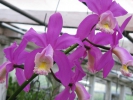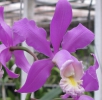|
|
|
|
|
| |
Flasks of
Cattleya harrisoniana 'Zephyr' × 'Williwaw' |
|
| |
|
|
| |
| Number: |
TN4568 |
| Name: |
Cattleya harrisoniana 'Zephyr' × 'Williwaw'
(Also commonly known as Cattleya loddigesii var. harrisoniana)
|
| Type: |
outcross (What's that?) |
|
Seed Donor: |
Dale Borders
|
|
Click to Enlarge

Pod Parent Flower |
Click to Enlarge

Pod Parent Capsule at 234 days |
Click to Enlarge

Pollen Parent Flowers |
Click to Enlarge

Pollen Parent Capsule at 257 days |
Click to Enlarge

Pollen Parent Blooming Plant |
Click to Enlarge

Offspring 'MC4930' Flower |
Click to Enlarge

Offspring 'MC6571' Flowers |
Click to Enlarge

Offspring 'MC6571' Flower |
| Offspring photos are siblings of the plants you would receive. |
|
|
|
| |
Culture Notes from Donor: Parent plants: Temperature range I (60-83°F)
Comments: Pod parent plant: A vigorous and easily grown species. Flowers are wonderfully scented.
Pollen parent plant: A vigorous and easily grown species. Flowers are wonderfully scented.
For additional origin/habitat information supplied courtesy of
Charles and Margaret Baker, see further below, near the bottom of this page.
|
Temperatures we attempt to use in the lab & greenhouse:
| For Species: |
|
Spring, Summer, Autumn: days average 82°F, nights 65°F; best fit is Intermediate 83-60°F
(Source:
Baker's Web OSC) |
| For Species: |
|
Winter: days average 74°F, nights 55°F; best fit is Cool-Intermediate 75-58°F
(Source:
Baker's Web OSC) |
| For Genus: |
|
Spring, Summer, Autumn, Winter: days average 83°F, nights 60°F; best fit is Intermediate 83-60°F
(
) |
|
About the name...
| Etymology of |
Cattleya |
|
Named in honor of William Cattley, English horticulturist in the 19th century.
(Source:
Pridgeon 1992) |
| Etymology of |
harrisoniana |
|
Named for William Harrison, English orchid enthusiast, during the 19th century, traveled Brazil around 1840.
(Source:
Mayr & Schmucker 1998) |
| Pronunciation of |
Cattleya |
|
KAT-lee-ya
(Sources:
Pridgeon 1992, Hawkes 1978) |
| Pronunciation of |
harrisoniana |
|
ha-ri-son-ee-AH-na
(Source:
Hawkes 1978) |
|
If you would like to direct someone to this web page, please copy and paste this URL into your email:
http://troymeyers.com/d?014568
| Flask Information |
| Availability: |
We have sold all of the flasks for this item. |
| You should: |
Consider getting individual plants or compots instead of a flask.
You can place a "Notify Flask Recipients" Request, and either we or a flask recipient may contact you when plants are available.
You may also place a "Notify Retries" Request, and if an identical pollination (the same parents) is done again, we'll let you know.
You may reserve a flask, but it's very unlikely you'll get one ...this could only happen if we found a flask that we didn't know we had. |
| Yield Estimate: |
630 plants (based on flask surveys done 10/05/2006 through 06/08/2007)
|
| Plantlet Sizes: |
From many flasks 10 - 65 mm plants (based on flask surveys done 10/10/2006 through 01/02/2008)
From one most recently surveyed flask 35 - 65 mm (01/02/2008)
|
|
You might also want to:
|
View the seed assay for this item.
View items of the same species.
View items of the same genus.
|
| Ordering Information |
| You are not currently logged in. |
|
You must be a registered user and be logged in to reserve a flask or place a notification request. Please log in:
|
|
|
|
|
|
| |
The origin/habitat information below is supplied courtesy of Charles and Margaret Baker
The following information is based on the name of the plant provided by the donor, and assumes that the name is correct. If the plant has been misidentified, then the following information may not be correct.
This text is copyrighted by the Bakers and may not be reproduced without permission.
ORIGIN/HABITAT: Brazil. Plants grow in riverside and swampy forests along
the Rio Paraiba and its tributaries in the western part of the State of
Rio de Janeiro from near Alem Paraiba to just east of Campos. They are
also found along tributaries of the Rio Muriae to as far north as the
State of Espirito Santo. Plants also grow the States of Minas Gerais and
Espirito Santo along the Rio Doce. They are sometimes found near sea
level, but they are more common at 1300–2600 ft. (400–800 m). Plants
normally grow 5–10 ft. (1.5–3.0 m) above the ground on trees with coarse,
rough, lichen-encrusted bark. Along with the orchids, these trees are
often laden with bromeliads, epiphytic cacti, gesneriads, and other
plants.
More about this information and the Bakers...
|
|
|
| |
|
|
|